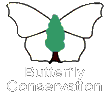
| Butterfly Conservation |
|
| saving butterflies, moths and their habitats |
 |
|
|||
|
| ||||
| Sussex Branch | ||||
|
| ||||
|
|
RSPB Pulborough Brooks, West Sussex **
Grid ref: TQ 059 165(visitor centre) Nearest town: Half way between Pulborough and Storrington
Access details Pulborough Brooks RSPB nature reserve, Wiggonholt, Pulborough, RH20 2EL, located about halfway between Pulborough and Storrington on the A283. Visitor centre open daily (except 25 and 26 December), from 10am - 5pm. Charge for non RSPB members.
Key species Brown Hairstreak Other common species Small, Large and Green-veined Whites; Large, Essex and Small Skippers, Common Blue, Holly Blue, Brown Argus, Orange-tip, Speckled Wood, Meadow Brown, Ringlet, Small Heath, Small Copper, Gatekeeper, White Admiral, Silver-washed Fritillary, Red Admiral, Small Tortoiseshell, Painted Lady, Purple Hairstreak, Comma, Brimstone, Peacock. Many common day flying moths such as Common Heath, Cinnabar, Mother Shipton, Burnet Companion, Speckled Yellow etc. Over 250 moth species have been recorded at the site. Occasional species Clouded Yellow. Marbled White recorded in 2002 and 2003. Green Hairstreak, Dingy Skipper and Wall Brown recorded since 1992 but apparently not present now. Purple Emperor recorded in 2000. White-letter Hairstreak has not apparently been recorded since 2001, although young elm suckers remain around the site and the butterfly may still be present
Site description 250 hectares of wet grassland, higher pasture, woodland, hedgerows and scrub, arable, heath and acid grassland. The site is managed principally for its breeding waders and wintering waterfowl, but supports an enormous range of birds and other wildlife. Mammals include water vole, dormouse and harvest mouse. 23 spp. of dragonfly have been recorded on the site. Adders, common lizards and grass snakes can be seen around the nature trail in the spring. Glow worms can be seen around car park.
Brown Hairstreaks are rarely seen, although in the winter, eggs are found on blackthorn right across the site, often right next to the nature trail, suggesting they are there to be found if the effort is made to look for them. White Admirals and Silver-washed Fritillaries are usually seen on Wiggonholt Common and are fairly scarce.
Author Pete Hughes (Site warden) |
||||||||||||||||||||||||||||||||||||||||||||||||||||
|
|
|
|
| Copyright Butterfly Conservation © 2006 Sussex Branch |
|
|
| Privacy and Copyright Statement |
|
|
| Butterfly Conservation is a registered charity and non-profit-making company, limited by guarantee. Registered in England No.2206468. Registered Charity No.254937. |
|
|
|
|